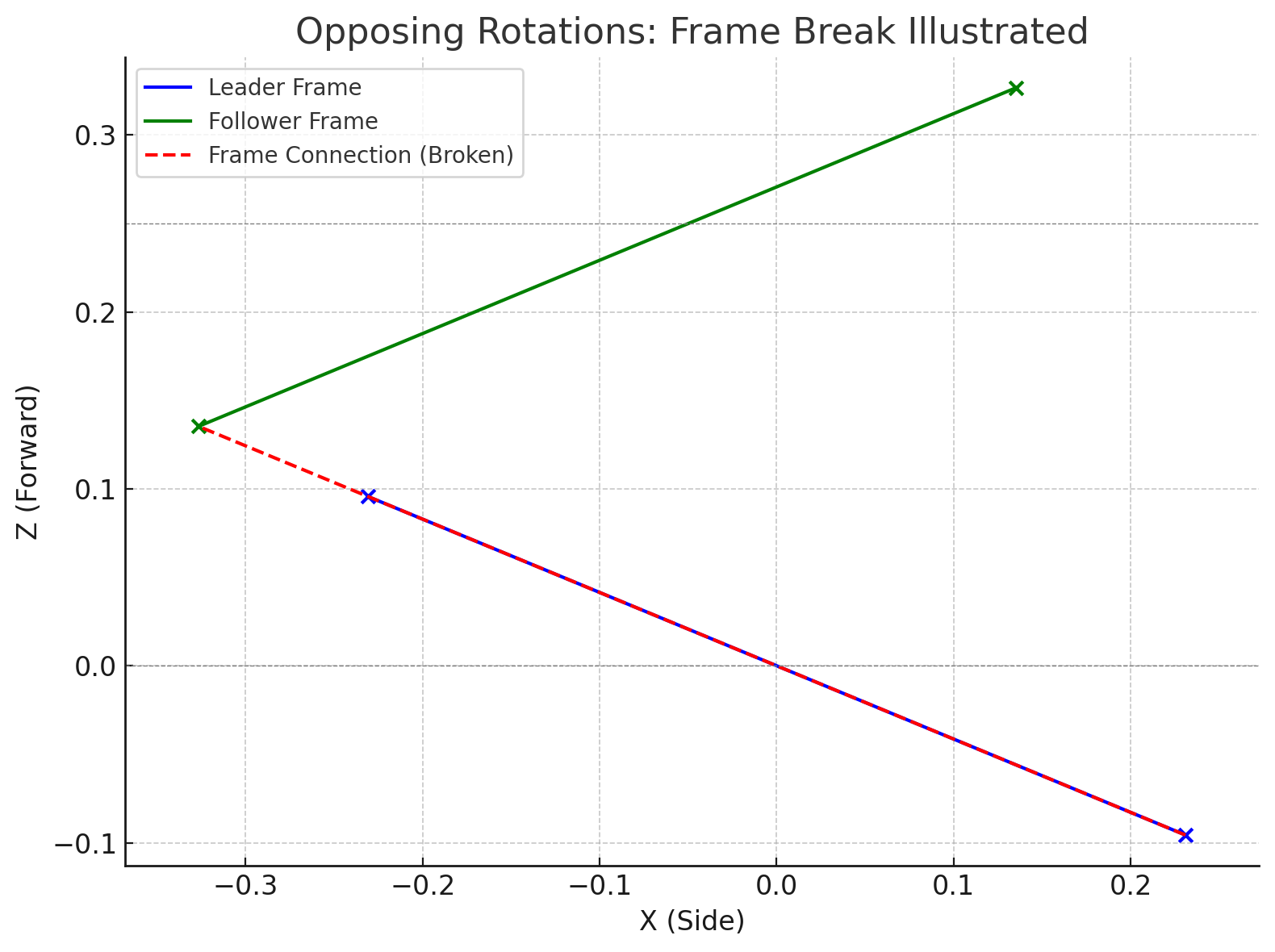The Promenade Frame Problem
Why the Syllabus Rotation into Promenade Breaks the Frame
📖 The Syllabus Says:
Foxtrot Promenade — Step 1:
LF side, CP to PP, F DW moving LOD, 1/8 turn L between previous step and step 1.
What this means in practical terms:
- The Leader is instructed to rotate 1/8 turn to the Left
- The Follower is simultaneously rotating 1/8 turn to the Right
- Both partners must remain in contact — i.e., connected through a stable frame
⚠️ The Contradiction
This rotation creates a situation in which:
- The Leader’s right shoulder must move leftward and slightly backward
- The Follower’s left shoulder must move rightward and slightly forward
This results in a geometrically divergent frame, where the connection point between shoulders have been compresses to the point where the frame on the Leaders right and Followers left has been collapsed.
Conclusion: If both dancers perform the syllabus-stated rotations at the same time, the connection at the shoulders will break. This violates frame integrity.
🔬 Visual Evidence
We plotted the resulting shoulder lines using accurate geometry:
- Blue line: Leader's shoulders after a 22.5° CW (Left) rotation
- Green line: Follower's shoulders after a 22.5° CCW (Right) rotation
- Red dashed line: Connection between Leader’s right and Follower’s left shoulders

🔧 Tension Vector Analysis
-
Closed Position (Rectangle Frame):
- All contact points support horizontal tension.
- Force from the leader’s left hand → transferred across frame → stabilized by follower’s right arm.
- Torso torque is symmetrically resisted.
-
V-Shape Attempt:
- Leader’s right arm and Follower’s left arm attempt to rotate outward from the connection.
- This creates a torque gap at the right shoulder (Leader) and/or left shoulder (Follower).
- The frame no longer distributes torque — it absorbs it.
[F] [F]
| |
(•)───────(•) ← original rectangular connection
| |
V-shape attempt:
(•)──→ ←──(•)
↑ ↑
shoulder shoulder
breaks breaksResult? The red dashed line is not perpendicular to either shoulder line, nor is it short enough to maintain contact. That’s your broken frame.
🧠 The Truth:
- Promenade is not created by opposing rotations.
- Promenade is created by a rotation of the follower with respect to the Leader.
✅ TL;DR:
The syllabus instruction for Promenade violates geometry. Unless you break frame, you can’t rotate oppositely and maintain hip contact.
🟦 How to Get Into Promenade Without Breaking Frame
This is the physics-approved way to achieve promenade without collapsing your frame or inventing new shoulder joints:
🪜 Step-by-Step: Simple, Clean, Effective
-
Example Starting Position:
- Feet together
- Closed Position
- Facing Wall (FW)
-
Transition to Promenade Position:
- Keep feet in place — still facing wall FW
- Rotate the torso and frame 45° to the right
- Result: Frame is now aligned F DW ALOD
- Feet haven’t moved — no wobble, no lurch
- Connection stays intact
-
First Step in Promenade:
- Leader’s RF (or Follower’s LF) steps forward and across in CBMP
- Direction: Moving DW
- This creates true outside partner without forcing the frame open
-
Fine-Tuning with Partner Gap Pg:
- A tiny shoulder rotation (~3–5°) adjusts based on partner gap
- Larger gaps = slightly more shoulder rotation to maintain hip alignment. At some point the gap gets so big that the frame will collapse.
🧠 Why This Works
- The feet stay stable until movement begins.
- The torso rotation aligns the frame with the new intended travel direction.
- CBMP becomes a natural result of this alignment.
- The shoulders and hips remain in structure, not stress.
🚫 The V Shape: A Beautiful Disaster
"Just make it a V!" — said every Bronze teacher who was handed a new student and a sales quota.
The V shape Promenade Position is the industry's favorite trick:
- Teach beginners a fake Promenade that collapses the frame.
- Sell it as “easier” and “introductory.”
- Once students move to Silver or Open, inform them that everything they learned was wrong.
- Profit.
🧨 What’s the Problem?
- The V shape is created by collapsing the frame at the Leader's right shoulder and Follower's left shoulder.
- It introduces tension distortions, breaks Poise Geometry, and destroys connection integrity.
- Worse still, students become dependent on it — it becomes baked into their muscle memory.
⚠️ This is the dance equivalent of training wheels that are welded to the bike.
✅ The Truth: Open Promenade Done Right
An Open Promenade is just a natural extension of proper Promenade Position:
- Start in Closed Position.
- Rotate the frame \(45^\text{o}\) to align F DW ALOD.
- Maintain Pg (Partner gap), torso connection, and alignment.
- Step 1 crosses in CBMP.
- Step 2 opens out (the "Open" bit) — no sudden pivots or hacks.
No collapsed V, no broken shoulders, no revenue-generating unlearning curve. Just clean, biomechanically sound movement.